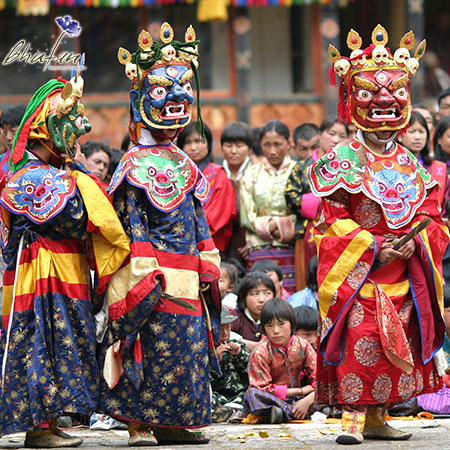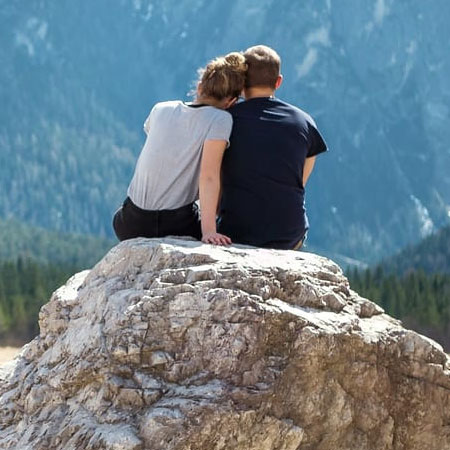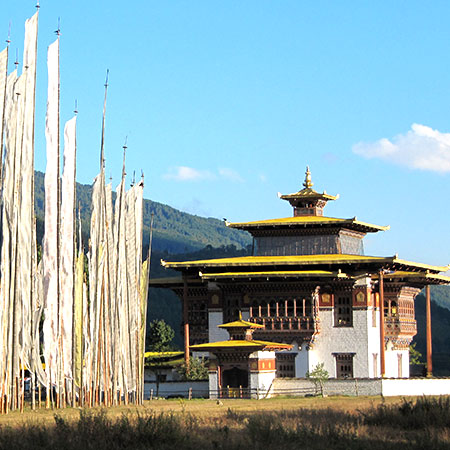Bhutan Tourist Information

Getting into Bhutan
Travel by Air
There are flights to destinations that include Bangkok, Delhi, Kolkata, Bagdogra, Bodh Gaya, Dhaka, Kathmandu, Guwahati, Singapore and Mumbai. At present two carriers operate to Bhutan, Drukair and Bhutan Airlines. There are also domestic airports in Yonphula in eastern Bhutan, Bumthang in central Bhutan, and Gelephu in south-central Bhutan.
Travel by Road
Phuentsholing, Gelephu and Samdrup Jongkhar are the only land border areas open to tourists. The town of Phuentsholing in south-west is located approximately 170 km east of the Indian national airport at Bagdogra. Gelephu, in south-central Bhutan, is another entry point to Bhutan. It is approximately 250 kms from Thimphu and the journey will take you through the sub-tropical areas of Bhutan before entering the alpine zone and then finally into Thimphu. The district of Samdrup Jongkhar in south-east Bhutan borders the Indian district of Darranga, Assam and is approximately 150 kms away from Guwahati, the capital city of Assam. The distance is about 700 kms and will take you a minimum of three days to reach Thimphu.
You can reach Phuentsholing via bus from Kolkata or Siliguri.
Travel by Train
To reach Bhutan via train, you first need to reach New Jalpaiguri Station (NJP) near Siliguri town and hire a car to reach Bhutan via Phuentsholing. Alternatively, you can also avail local buses and shared taxi to reach Bhutan from Phuentsholing. Another option is to reach the station of Hasimara. The distance from Hasimara to Phuentsholing is only 17 kilometers.
Visa/Entry Permit
With the exception of visitors from India, Bangladesh and Maldives, all other visitors traveling to Bhutan need a visa.
Indian, Bangladeshis and Maldivian nationals can obtain a permit at the port of entry on producing a valid passport with a minimum of 6 months validity (Indian nationals may also use their Voters Identity Card (VIC)).
All other tourists must obtain a visa clearance prior the travel to Bhutan. Visas are processed through an online system by your licensed Bhutanese tour operator directly or through a foreign travel agent.
Sightseeing in Bhutan
Bhutan maintains a strict control over travel and tourism in order to maintain the holiness of the land. Every year a handful of travelers can reach Bhutan. So if you plan to visit Bhutan, you first need to acquire a permit. Once you have received the permit, you can visit the land of Bhutan albeit the entry is restricted in many areas of the country and you need to obtain individual permits to enter the surrounding regions.
Guides
There are over 1000 licensed and active tour guides working in the country.
In order to ensure that visitors receive high quality professional service, every guide must complete a training course. Guides are trained to specialize in either cultural or adventure tours. Many guides complete language courses in German, Japanese, Thai and other languages so that they can easily communicate with guests and all are proficient in English. All tour operators must employ only registered and certified guides.
Accommodation
A wide variety of accommodation is available ranging from luxurious 5-star hotels to cozy little hotels and homestays in traditional Bhutanese homes and settings. Visitors can be assured of their warmth and comfort of the hotels. Similarly, the ambiance and hospitality offered by the hotels are incredible.
The types of accommodations can be divided into:
- Hotels
- Resorts
- Farm-stays
- Home-stays
Additionally visitors embarking on long treks will be provided with tents and whatever other camping equipment is deemed necessary. Regardless of where they stay, visitors can be assured of their comfort and traditional Bhutanese hospitality.
ATM Locations and Currency
ATMs are located within all main towns throughout Bhutan, where money can be withdrawn using a Visa or MasterCard. For concerned travelers a list of ATM locations throughout Bhutan is provided in the following links.
Bhutan’s currency is the Ngultrum (Nu.) It is at par with the Indian rupee which is widely accepted in the country. In addition, POS (Point of Sale) services are available nationwide, meaning visitors can pay by credit card at most hotels and handicrafts stores.
Travel Tips
Checklist
The following information acts as a guide when traveling to Bhutan. This practical advice is not a comprehensive list but should provide some useful information for you as you plan your travelling.
Travel / Medical Insurance
The Royal Insurance Corporation of Bhutan has initiated a travel and medical plan solely for our visitors. Travel insurance can be provided through your Bhutanese tour operator or international partner. You may also visit the Royal Insurance Corporation of Bhutan website at www.ricb.com.bt for more information.
Banking
Financial institutions in Bhutan have been greatly enhanced and today we have a number of banks that cater to the needs of the people. Some of the banks that you can avail of while in Bhutan are the Bank of Bhutan Limited, the Bhutan National Bank, the Druk PNB and the Tashi Bank. Traveller’s cheque can be easily withdrawn and exchanged for local currency. Many of these banks provide internet banking facilities.
Electricity
All major towns are well connected with electricity that runs on 220/240 volts with round hole two-pin and three-pin power outlets.
It is recommended that you bring flat-to-round pin converters for your electronics if necessary, however, most hotels offer multi plug sockets. Bhutan is a carbon neutral destination. Our energy is clean and green generated by hydro power.
Photography
Bhutan offers immense opportunities for photography especially during outdoor sightseeing trips.
However you should check with your guide before taking pictures or filming inside Dzongs, temples, monasteries and religious institutions as in some area photograph/filming is not permitted.
You are free to capture images of the landscape, the panoramic views of the mountain ranges, rural life, flora and fauna, distinctive Bhutanese architecture and the exterior of Dzongs and Chortens.
Shopping
Some popular handicraft items available for purchase are hand-woven textiles of raw silk or silk, carved masks of various animals, woven baskets of cane and bamboo, wooden bowls known as Dapas, handmade paper products or finely crafted gods of silver. Other items you may be interested in are the exquisite Buddhist thangkha paintings or Bhutan’s wide array of colourful and creative postage stamps. You can come across these items in the many handicraft shops in and around Thimphu and in other major towns. Please remember that buying and selling of antiques is strictly forbidden in Bhutan.
Gratuities
Tipping is a purely personal matter. We leave it up to you as to whether you want to give a gratuity to your guides and drivers. However, if doing so, we recommend that you place the gratuity in an envelope.
Communications
The country has a good network of telecommunication facilities. Most hotels and cafe’s offer Wi-Fi internet access. Bhutan has a comprehensive mobile (cell) phone network with global roaming also accessible.
Clothes & Other Paraphernalia
With great attitudinal variations, weather is quite mixed in Bhutan. So be prepared to face the unforeseen weather conditions.
We expect visitors to dress modestly and respectfully especially if you are planning a visit to the monasteries, Dzongs and other religious institutions. Long pants and long sleeved tops should be worn when visiting such places. As a mark of respect, be kind enough to remove your hats, caps etc. as you enter religious and administrative premises, institutions and in any other place that you come across with the national flag being raised.
Measures, Weight & Time
Bhutan ascribes to the metric system and most weights are measured in gram (g) and kilogram (kg). The standard time is 6 hours ahead of GMT.
Health Inoculations
Before embarking on a trip to Bhutan, please seek advice from your doctor with regard to vaccinations and appropriate medication you should have prior to your travels. As a minimum you should have tetanus, typhoid and hepatitis A inoculations.
Precautions
Bhutan is one of the safest countries in the world however you should still exercise caution when visiting. Please ensure that your belongings especially your passports, cameras, wallets and purses are properly secured. Please refrain from leaving such items within sight or in locked vehicles while sightseeing.
Avoid drinking tap water which has not been boiled or ice cubes in drinks at all times as most water sources in Bhutan are untreated. One can easily acquire affordable treated and bottled water.
Also, Bhutan has a duty to protect its citizens from drugs and tobacco products. To do this we need your help and cooperation. Please co-operate if stopped and asked about your baggage. Please do not carry tobacco goods in excess of the set limit. For more information please see following link. Tobacco Control Act
Public Holidays
Public holidays are observed throughout the nation. However, each Dzongkhag has its own list of regional holidays that are observed especially during the annual Tshechus (Religious festivals). For such a list, please contact your service provider or travel agent.
When is the best time to visit Bhutan?
Bhutan has four distinct seasons and each season has its own beauty and charm. Bhutan is an year-round destination. So, it is entirely up to you to decide your travel period.
Spring (March, April & May)
Spring is a botanist’s delight as various flowers start to bloom.and plants start budding after their long dormancy in winter. Flowers such as rhododendron, wild azaleas, and edelweiss cover the meadows like carpet and add a new sense of wonder.to the Bhutan’s landscape.
Summer (June, July & August)
It is an abundant time of the year as flowers are in full bloom and valleys are covered in green, weeping willows sweep the banks of many of the river and pine cone glisten in the sun, so full with risen they are ready to plummet to the ground.Autumn (September, October & November)
This is the time when the entire landscape turns into golden color. The farmers harvesting their crops in the golden colored paddy fields under the crisp blue skies is just an amazing view of Bhutan’s landscape in the Autumn season.
Winter (December, January & February)
Winter has its moments. The days are full of sunshine while evenings can turn chilly. Soft turfs of clouds drape lazily over mountain tops as if waiting for new life to blow it across the landscape. The winter season in Bhutan gives one a clear view of the world’s highest Himalayan mountain ranges covered in snow.

































